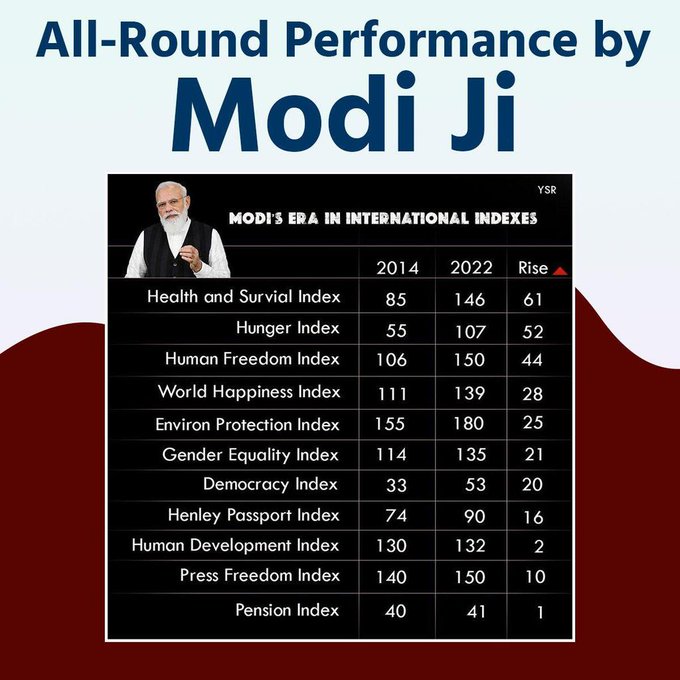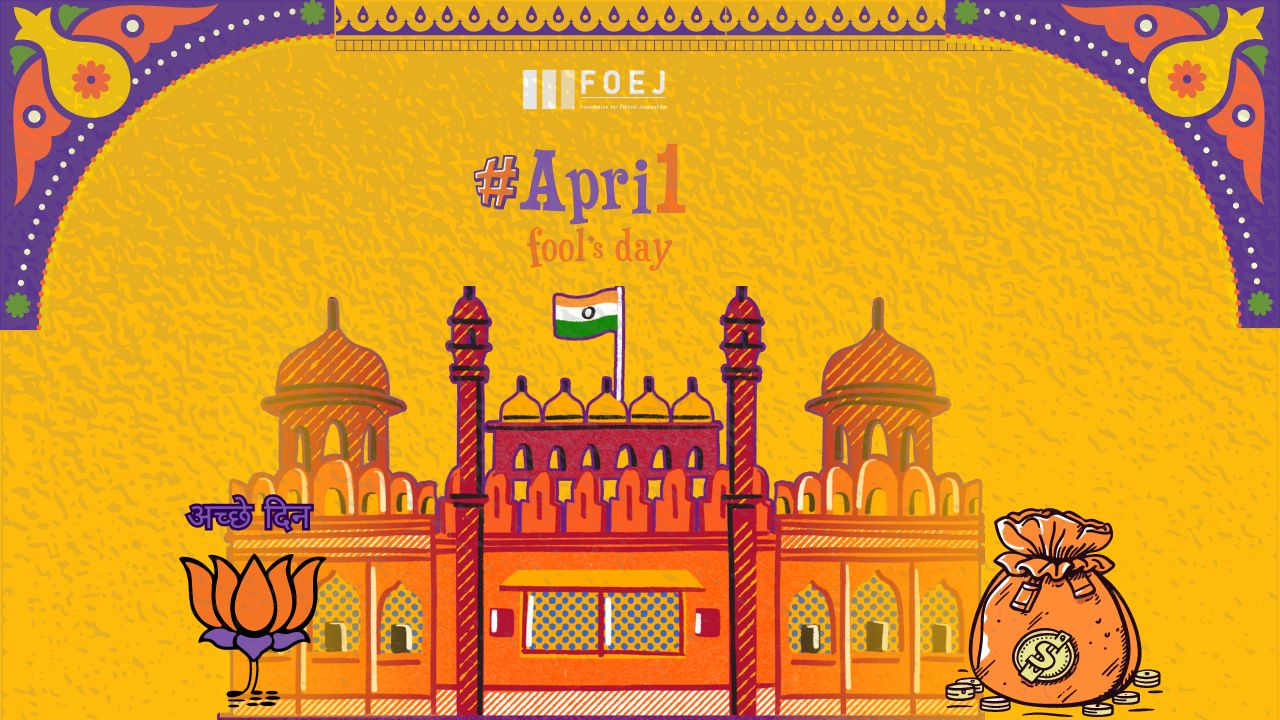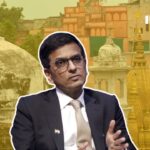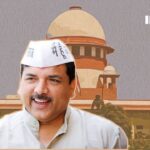In 2014, a wave of anti-corruption swept through India, sending chills through the ranks of dishonest bureaucrats and sparking a statewide agitation against the UPA administration. While fantastical idealism became the dream of Indian citizens to clean up the Augean stables, April Fool’s Day wasn’t far behind.
“April Fool is a foreign concept; in India, we have acche din”. Many on social media used #April Fools Day on X, previously Twitter, to showcase the current political situation in the country. A cartoon by Satish Acharya surfaced X that presents the promise by Modi to ‘double’ the income of farmers in India but failed terribly.
Another post carrying infographics was circulated on social media. It shows the “probability of getting fooled.” Whereas the chances of getting fooled on April Fools Day are lesser, the chances of getting fooled on the election day reach the top.
Anti-Corruption
India’s ranking on the Corruption Perceptions Index (CPI) for 2023 dropped to 93 from 85 in 2022, according to a Transparency International report released on Tuesday. Despite this decline, the report noted a minimal fluctuation over the two years, precluding any definitive conclusions regarding significant change.
The CPI ranks countries and territories based on perceived levels of public sector corruption, utilizing a scale of 0 to 100, where 0 represents high corruption and 100 signifies very clean governance.
“India (39) shows score fluctuations small enough that no firm conclusions can be drawn on any significant change. However, ahead of the elections, India sees further narrowing of civic space, including through the passage of a (telecommunication) bill that could be a ‘grave threat’ to fundamental rights,” the annual report read.
Modi’s Promise and Reality
Narendra Modi’s pledge of a corruption-free administration during the 2014 election campaign was not kept. His initiatives, such as demonetization, failed to address corruption and harmed the economy.
Speaking about the demonetization case, Justice Nagarathna stated that when demonetization was executed in 2016, 86 percent of the currency was made up of 500 and 1,000 rupee notes, which she thought the federal government neglected.
“The central government lost sight of the fact that 86 percent of the currency comprised 500 and 1,000 notes,” remarked Justice BV Nagarathna, as cited by Bar and Bench.
Regarding the outcome of demonetization, she pointed out, “98 percent of the currency came back, so where are we in terms of eradicating black money?”
Reflecting on her perspective at the time, Justice Nagarathna expressed her initial belief that demonetization could have been a means of legitimizing illicit funds. “I thought (at the time) it was a good way of making black money white money,” she said, adding, “What happened with regard to income tax proceedings thereafter, we do not know. So this common man’s predicament really stirred me, and I had to dissent.”
Justice BV Nagarathna stressed that the execution of demonetization was flawed, stating, “The manner in which demonetization was done was not correct,” as reported by Live Law. She criticized the lack of a thorough decision-making process and the haste with which it was carried out, implying that even the then-Finance Minister may not have been fully informed of it.
Selective Anti-Corruption Measures
A news post with #AprilFoolsDay by India Now went viral that quoted Modi as saying, “ED is the institution that operates independently; we don’t interfere with their work.”.
Modi’s anti-corruption efforts are seen as biased and targeting political rivals while allowing corruption within his own party to thrive. Many have criticized Modi’s majority in parliament and public support for a failure to effectively address corruption in Indian politics without bias or favoritism.
The recent arrests of Arvind Kejriwal and K. Kavitha and frequent raids on Mohua Moitra and many leaders from the opposition parties of the BJP have raised questions regarding the role of the ED and CBI in selectively targeting. Critics say that the use of recent raids to suppress political opposition undermines democracy and encourages corruption.
Electoral Bonds Controversy
The introduction of electoral bonds by the Modi government has faced criticism for facilitating corruption and a lack of transparency in political funding. In a major decision in February, the Supreme Court invalidated the Electoral Bonds Scheme, putting an end to anonymous political party funding and ordering SBI to stop issuing electoral bonds. The majority decision also struck down comparable revisions to the Income Tax Act and the Representation of the People Act, which required openness in political donations.
The BJP was the largest recipient of electoral bonds, receiving Rs 6,060.5 crore in total, followed by the All India Trinamool Congress (TMC), which received Rs 1,609.5 crore, the Congress, which came in third with Rs 1,421.8 crore, the Bharat Rashtra Samithi (BRS), which received Rs 1,214.7 crore, and the Biju Janata Dal.
The majority were encashed before the 2019 Lok Sabha election, followed by the 2021 and 2023 assembly elections. Before the 2019 Lok Sabha elections, Rs 1,771.57 crore in bonds were redeemed, adding to India’s record-breaking election expenditure.
Bonds worth Rs 292 crore were redeemed prior to important state assembly elections in January and April 2021, with just Rs 80 crore cashed after July 2021. Between July and December 2023, before key state assembly elections, bonds worth Rs 1,149 crore were encashed, compared to Rs 527 crore between January and April. This pattern depicts strategic money use in accordance with elections.
3,598 Days of Fooling?
Mallikarjun Kharge, the Congress president, has continuously slammed the BJP administration, stating that Prime Minister Narendra Modi has failed to keep his promise of creating 2 crore jobs each year. Kharge accused Modi of duping the country with unfulfilled promises, including a pledge to deposit Rs 15 lakh in each citizen’s account. He noted rising unemployment and 30 lakh unfilled posts, meaning that the BJP’s refusal to fill them is meant to prevent underprivileged groups from seizing these opportunities.

Rahul Gandhi echoed these sentiments, condemning the BJP’s promises and encouraging young people to reject illusions and embrace change through the Congress’s ‘Yuva Nyay’ initiative.
“Narendra Modi ji, did you have any plans for employment? This question is on the lips of every youth today. In every street and village, BJP people are being asked, Why was the lie told about providing 2 crore jobs every year?” he asked.
In addition, Rahul questioned the BJP-led government for the role they are playing for the OBC in our country. “Narendra Modi ji uses the word ‘OBC’ in every speech, but why is he scared of the caste census? OBCs have to become aware that they are being ditched,” Gandhi said.
Reiterating his earlier stance on only 3 out of 90 secretaries of the government being from the OBC community, Rahul said, “The government is run by 90 officers. MPs do not run the government. Out of these 90, only 3 people are from the OBC community. The BJP spends only 5 percent of the country’s budget on the OBCs. The population of the OBC category is more than 50%, but Modi ji hides this. He says his government supports OBCs, but he lies.”
#AprilFoolsDay
























